
Attempted Sailboat Bottom-Cleaning Goes Sideways
Sausalito’s waterfront was turned into a temporary boatyard when two sailboats were careened on the Dunphy Park shoreline Saturday morning. When Sausalito police officers arrived on the scene the owners told them they had brought the boats ashore to scrape and clean the bottoms. The owners were informed their process was illegal.
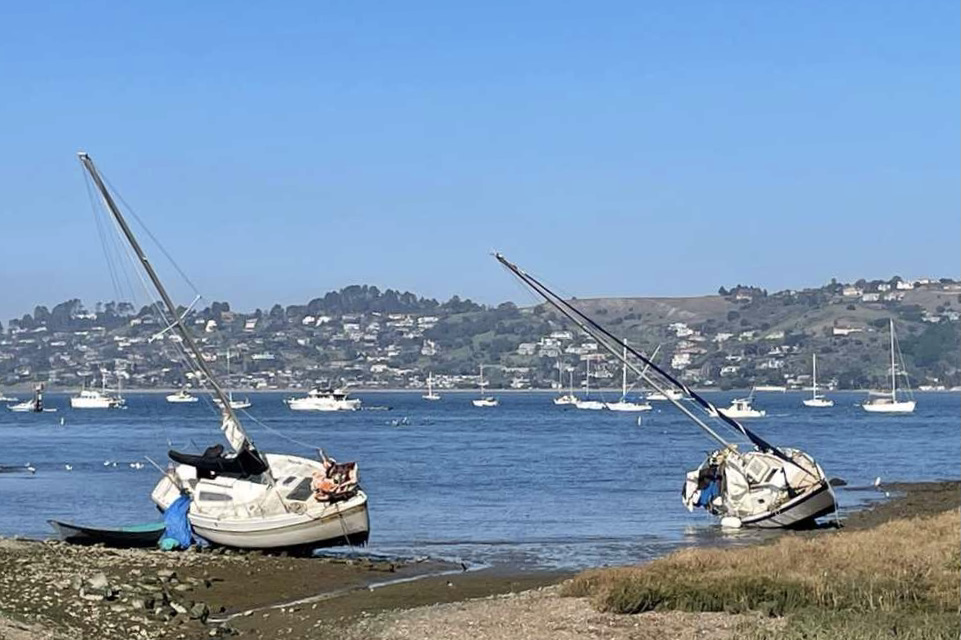
According to a Sausalito PD press release, the owners had initially refused to move the boats and were later each issued a 72-hour warning. Failure to comply would result in the boats being towed and impounded at the owners’ expense. As the foreshore on which they had landed is under the jurisdiction of the City of Sausalito, the unnamed skippers were also cited under the city’s Municipal Code section 16.04.070 — a misdemeanor with a potential penalty of $500. (Not a lot to pay for a bottom cleaning, if you can get away with it.) According to comments on social media from a local who witnessed the scene, “As soon as the police left, the work resumed.”
However, the situation later went sideways. While one of the boats successfully sailed away, the other remained, became stuck in the mud, heeled over, and filled with water, its removal now requiring a salvage team. Pollutants emerged from the sunken vessel, and Parker Diving Service was called in to place a protective boom around the vessel in an attempt to contain contaminants that were seeping into the Bay.
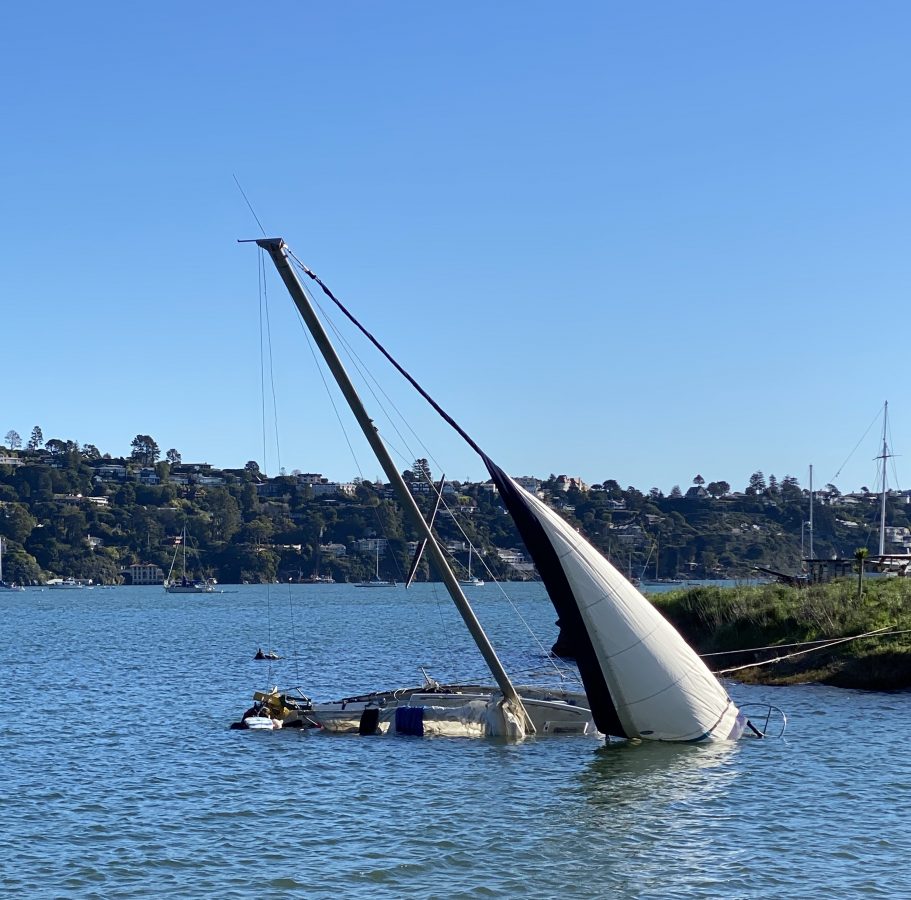
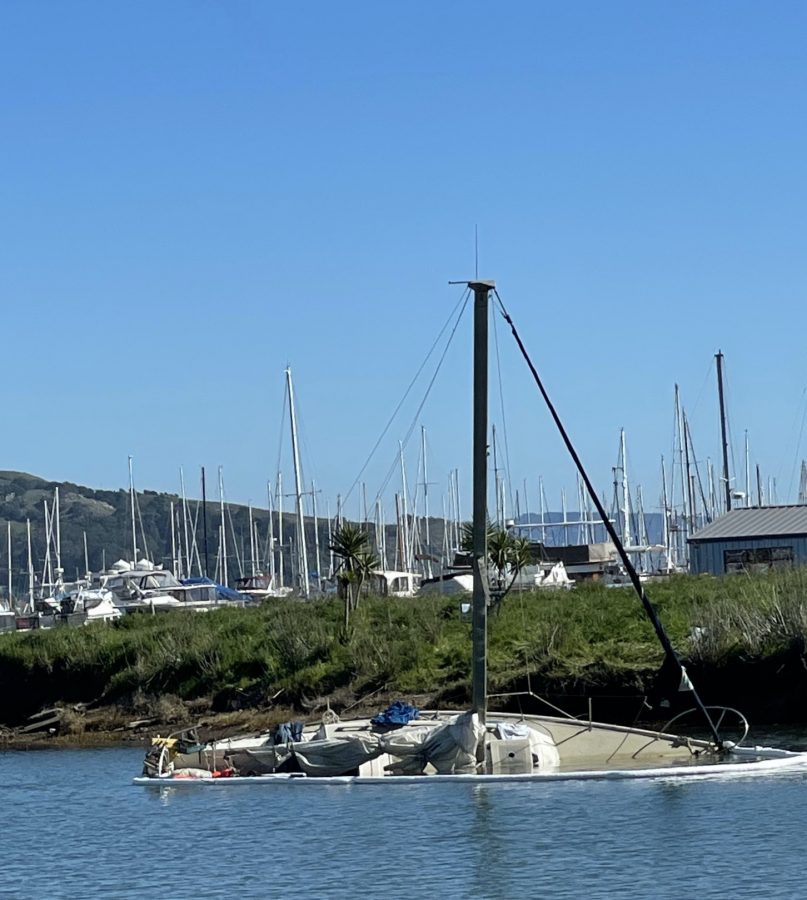
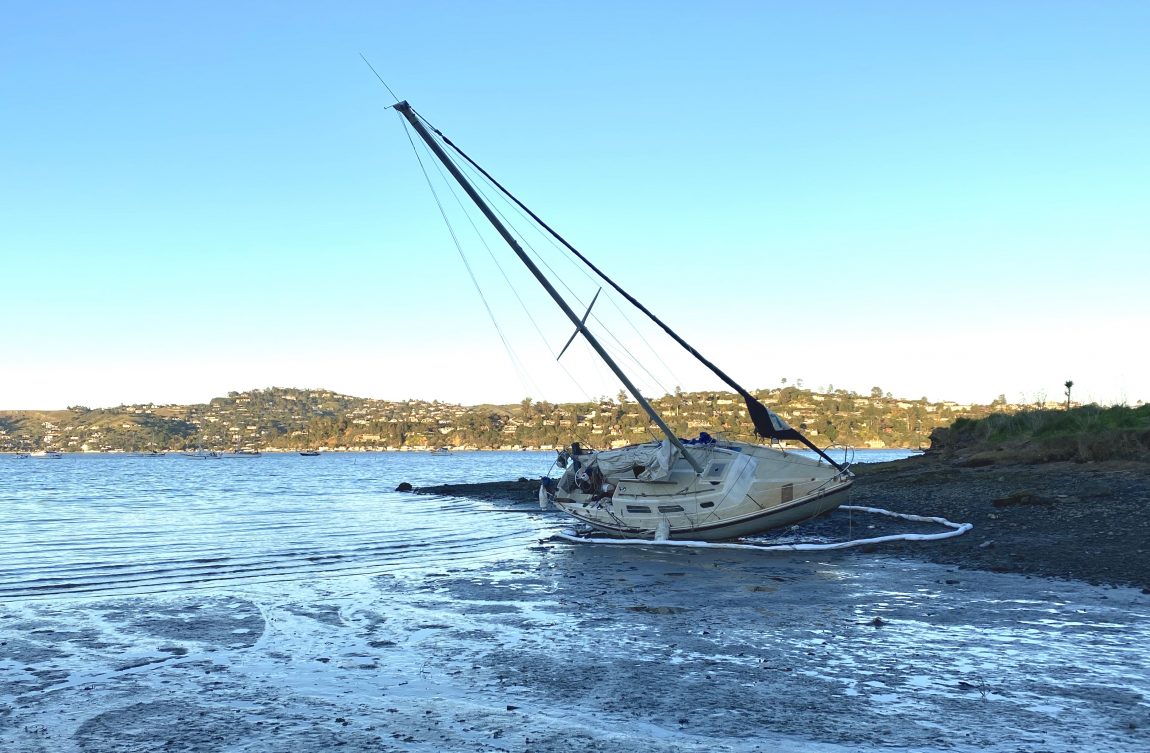
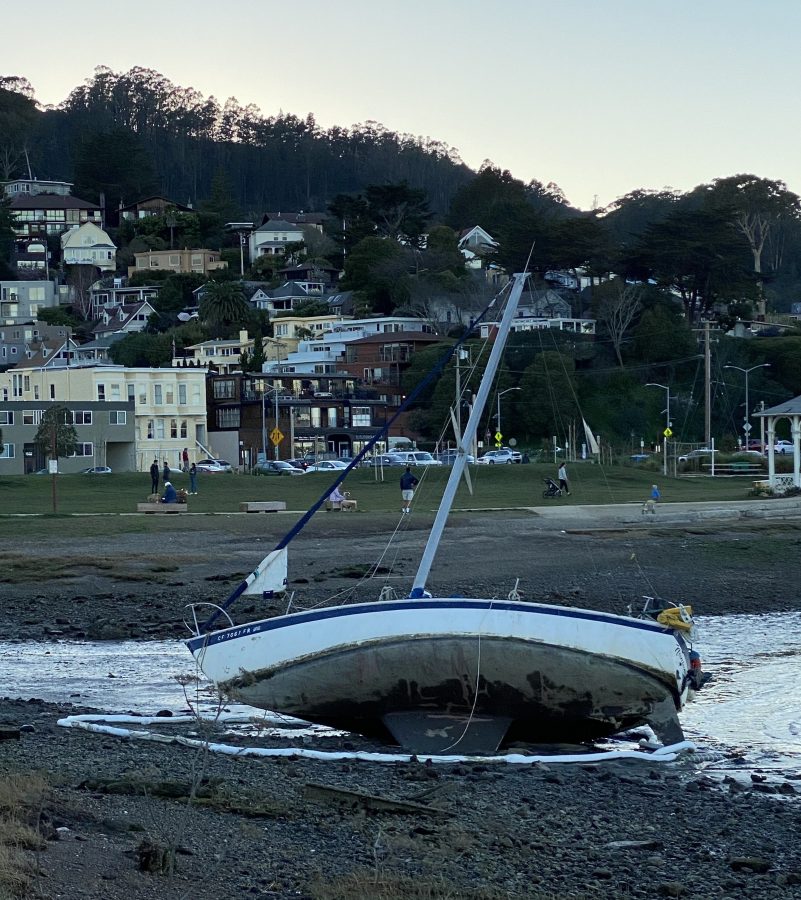
On Thursday, the remaining sailboat was salvaged by a Parker Diving team, with boats from the PD, Coast Guard and RBRA keeping the area clear of onlookers. When Latitude 38 arrived on the scene the sunken vessel was being pumped out in preparation for towing.
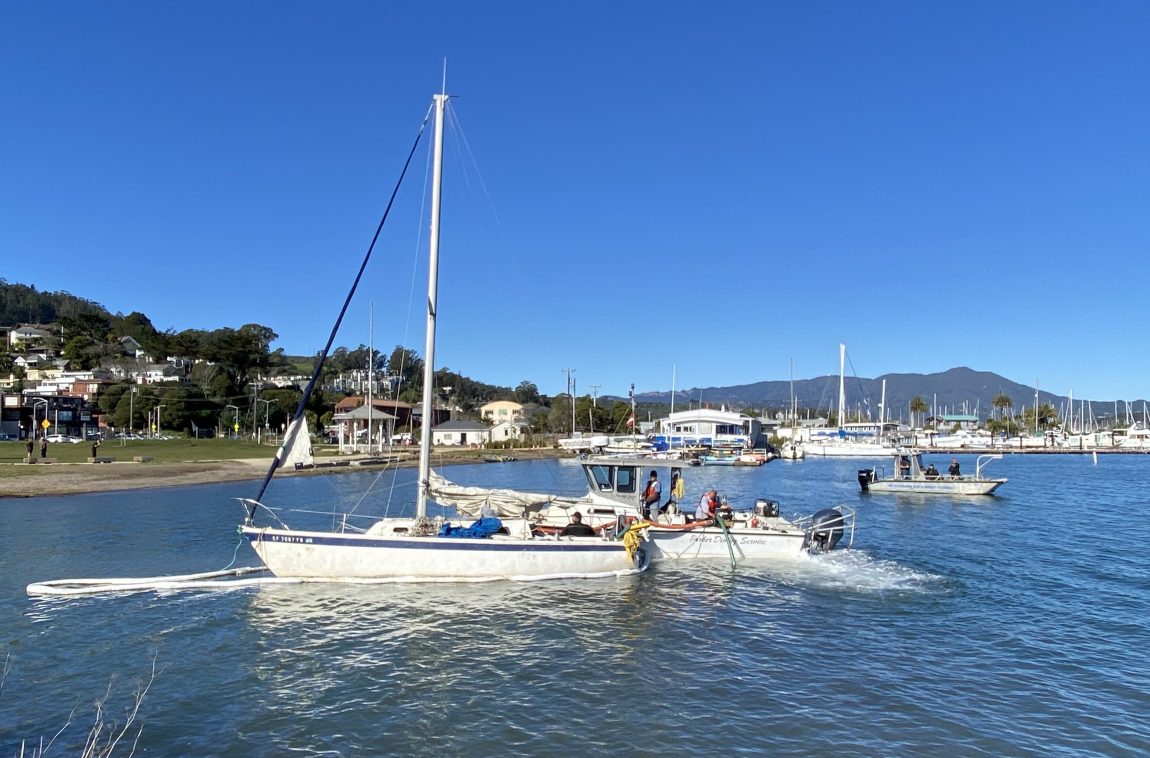
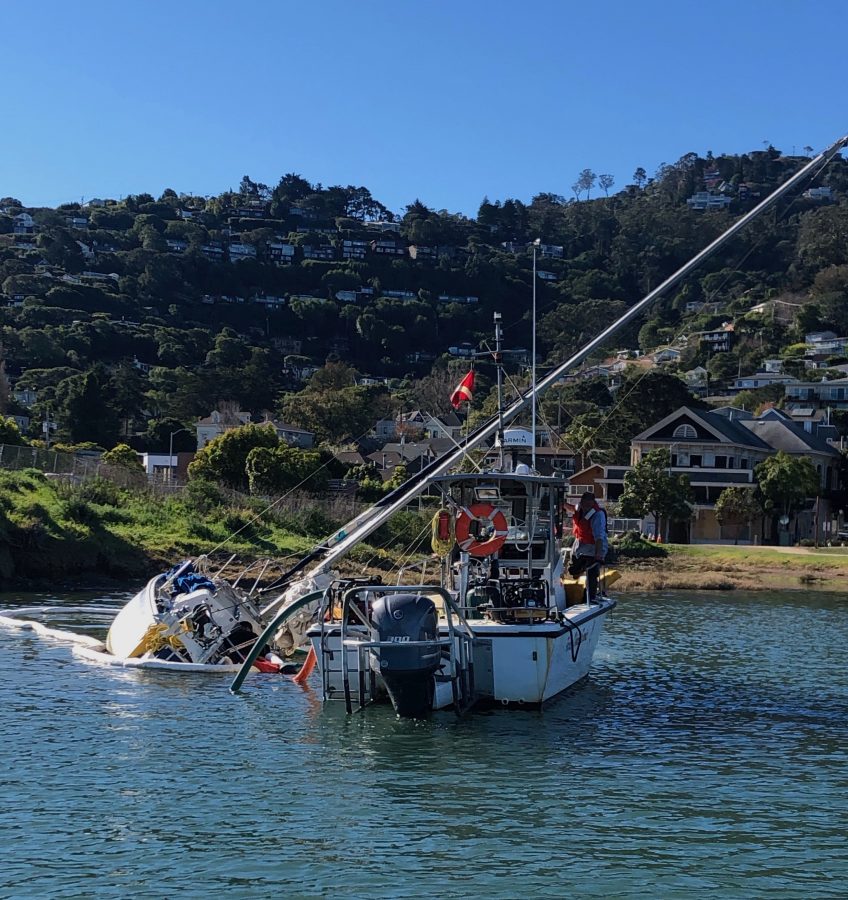
Richardson Bay Regional Agency acting harbormaster Jim Malcolm told us the Sausalito police had called him on Saturday morning to seek the agency’s expertise and assistance. A former USCG boatswain’s mate master chief petty officer, Malcom told us they had a saying in the Coast Guard, “When ships were made of wood and men were made of steel …” He acknowledged the practice of careening boats to clean and work on the bottoms was not uncommon back in the days when there were no engines or other potential threats to the environment. But he added that it required a certain degree of knowledge and daring. “It’s not just as easy as beaching your boat and waiting for the tide to float it.”
The salvaged boat has been towed away, its fate as yet unknown, but we understand it will not be returning to its anchorage on Richardson Bay.

I have done this about 50 years ago at Cabrillo Beach in San Pedro. It went very well though not sure I wouldever try it again.
Not that I would ever try to careen my own boat, but found it interesting in Wikipedia that the boat is supposed to be beached BROADSIDE to a STEEP beach, and then levered over sideways by lines from the mast to a strongpoint on shore. (If the boat is beached bow-on to a shallow beach, it seems inevitable when the tide comes in that at least the cockpit may be swamped before a hopefully observant crew can untether the mast and refloat the hull.)
I careened my sailboat, in the harbor at San Filipe, while I was in the Sea of Cortez. During a big tide, I brought my boat close to the shore, laid bow and stern anchors parallel to the shore. Another anchor was laid off shore. I secured a masthead halyard to a five gallon jug of water onshore, to make sure that when the tide went out, I would lay the boat properly. I scrubbed and antifouled the port side. I stayed on the boat that night, on a leeward bunk. Quite a weird sleep that night, like a knockdown in freeze motion. The next day, after I was afloat, I switched bow and stern positions. The tide again receded. I antifouled the starboard side. I then retrieved the bow and stern anchors from their now beach position. Returned the mast halyard to its proper location. Once I secured the offshore anchor to the bow, I waited for the tide to return. Once afloat, I pulled myself offshore, and moved to deeper water. The whole experience was satisfying.
Nice and well thought out! Congratulations
Keep it friendly??? When you make the crack “if you can get away with it” in the context of paying a $500 fine as compared with legitimate haul out and bottom paint job??? Are you out of your mind?
The shit that is scraped off on a public park property, the paint in the water (a violation of state and federal clean water law)… it is an insult to me, a Saustown resident AND boat owner that the PD merely gave 72 hour notice. Both these #$@%*! should be KEELHAULED
Dane, thanks for your comment. We don’t suggest that people disregard the environment and the law to save a few dollars. The fact that these boat owners thought they could drive ashore and clean their bottoms is laughable, but they tried all the same. Clearly, the situation angered you and that’s understandable. The PD did arrive and do what was within their power to do, and for that at least we can be grateful. Our tongue-in-cheek comment was just that — a recognition of the ridiculous nature of their flaunting of what most people accept as being fair and just. There is already enough angst and disharmony in the Bay over boats, so perhaps this is a good time to simply let those who prefer to work against the rules suffer the fate of their follies. Hopefully, the end result of the weekend’s jaunt will cause others to think twice before attempting this or other equally inappropriate boating practices.
While careening was common in the past (in fact we scraped an Olson 30 bottom that we left leaning against a Sausalito bulkhead at high tide 30+ years ago), it is simply no longer acceptable. The Bay is far cleaner than it has been in years, though still not clean enough to pick mussels from the shore and take them home for dinner. Like you, we’d love to see the Bay’s health restored so it would support a more diverse ecosystem including a return of native oysters which, as filter feeders, can actually be part of the solution. New York Harbor has the Billion Oyster Project, https://www.billionoysterproject.org/, and San Francisco Bay has the Wild Oyster Project, https://wildoysters.org/, aimed at returning filter feeders to polluted waters to help clean them up. A recent story on KQED says the primary problem preventing restoration is agricultural runoff and not boats but we know we all have to change behaviors to support the continuing improvement of Bay waters.
On the other hand, we do get wistful at the loss of individuals who solved their own problems with skills and creativity. We miss some of the swashbuckling, wranglers with a ‘can-do’ attitude who managed to do what nobody said could be done. Careening boats on beaches in California started way back in 1579 when Sir Francis Drake careened the ‘Golden Hind’ in Drake’s Bay. Long before there were boatyards, travel lifts and marine railways boats were getting built and careened on the San Francisco Bay shoreline. This eventually became major shipyards, like those in Marinship, scattered around the waterfront building ships for WWII on the shores. This was good for the war effort but a disaster for the Bay. Today you can hardly imagine how far we’ve come from the polluted catastrophe that was San Francisco Bay in the 60s. Luckily we’re reminded of it every time we sail when we see the harbor porpoises that returned to the Bay years ago. To learn more about the whole arc of the Bay’s history watch the excellent four-part series, Saving the Bay (https://savingthebay.org/)
If you want to see another example of a sailor coming up with a creative solution have a look at our story from August 2010 when a boat owner stepped the mast of his 1967 O’Day Outlaw by hanging it from the Rt. 37 bridge over the Petaluma River. That was creative! https://www.latitude38.com/issues/aug-2010/#78 And, ultimately successful.
The Bay is far cleaner than it has been in decades and we should all follow the laws and our conscience to continue that trend. $500 may not be enough of a deterrent but keelhauling is far too severe. We’d like to see a healthy Bay that accommodates people sailing at all levels on the economic spectrum. — Latitude Editors
The stuff scraped off the bottom is marine life and not harmful to the environment, Divers do it legally all the time. Sanding on the bottom, which would be nearly impossible, would be illegal. To refloat the boat, they should have taped a tarp along the side of the boat to keep the water from coming in. It is unfortunate that the legal bailouts are just plain gouging boaters so that those who do not have a fortune must be creative.